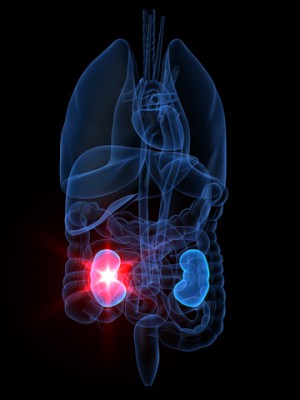Understanding renal blood flow and autoregulation
Clinical relevance
When faced with a patient suspected of having, or proven to have AKI, intrinsic renal disease and obstruction should always be excluded. However, the cause is most often reduced ‘filtration pressure’ within the kidneys due to disease outside the kidneys, possibly exacerbated by concomitant treatment with medications that compromise the protective intrarenal reflexes that try to maintain perfusion pressure. The essence of these cases is reduction of the pressure within the glomerular capillaries that drives filtration, management focusing on restoring this pressure. Even when the insult is toxic or due to urinary tract obstruction, the vascular reflexes that preserve the filtration pressure in the kidneys may still be important.
The NCEPOD enquiry into AKI in secondary care (Acute kidney injury: adding insult to injury) highlighted inadequate assessment of patients at risk of AKI as a major contributory factor to the documented avoidable deaths (3). The most important assessments highlighted by this report were assessment of volume status, assessment of comorbidity and nephrotoxic medications. The importance of these contributory factors is understandable in terms of their impact on the blood supply to and therefore pressure within the glomerular blood vessels. The assessment is in many respects a search for factors that may compromise glomerular perfusion pressure.
The kidneys are able to protect themselves using autoregulatory reflexes. These are inhibited by certain medications.
In situations where incoming pressure is reduced (e.g. due to vascular disease, hypovolaemia or reduced cardiac output), autoregulatory mechanisms are essential to maintain perfusion pressure and therefore GFR. If reduction of inflow is moderate, GFR may be maintained in the normal range by these mechanisms, albeit reduced compared to the normal GFR in this patient. Thus, serum creatinine concentration may rise, but only moderately and such reductions in GFR should be considered entirely recoverable with appropriate intervention. However, autoregulation may not be able to compensate for more severe challenges to glomerular perfusion and a more significant decline in GFR will be seen with more serious biochemical disturbance. This may still be recoverable, but at this stage the chances of recovery to baseline renal function are reduced. Furthermore, the autoregulatory mechanisms become essential to maintain safe renal function and prevent irreversible damage.

NSAIDs and COX-2 inhibitors inhibit afferent arteriolar vasodilatation by inhibiting PGE2 production and ACEI/ARB inhibit efferent arteriolar vasoconstriction by inhibiting the production or action of angiotensin II. These medications therefore severely restrict the ability of the autoregulatory reflexes to maintain kidney function when renal blood flow is reduced.
From this it can be seen that management of AKI requires treatment of any underlying condition that reduces the incoming perfusion pressure whilst ensuring autoregulation is not compromised by NSAIDs (including COX-2 inhibitors) or drugs blocking the local renin-angiotensin system.
If the filtration barrier is damaged (e.g. in CKD) these haemodynamic considerations become even more important, as any reduction in GFR will be more critical.
The aim of much of the management of AKI is to recognise these changes at an early ‘physiological’ stage, when these intrarenal vascular reflexes are still able to maintain normal or near normal function, and to intervene before irreversible ‘pathological’ changes supervene.
- The majority of cases of AKI are due to vascular injuries to the kidney
- Glomerular filtration rate is maintained by a complex system of autoregulation
- This autoregulation aims to maintain the glomerular perfusion pressure
- The autoregulation at the level of the glomerulus relies on controlling the resistance in the incoming (afferent) and outgoing (efferent) arterioles
- Prostaglandins regulate the afferent and Angiotensin ll regulates the efferent arterioles
- Drugs that affect these autoregulators can contribute to AKI risk (e.g. NSAIDS that inhibit prostaglandin E2 and ACE inhibitors and ARBs that inhibit production or action of angiotensin ll)
- Extra renal disease can also be a contributory factor e.g. cardiovascular disease and in particular the vascular complications of diabetes, as well as the relative hypovolaemia seen in acute illness

